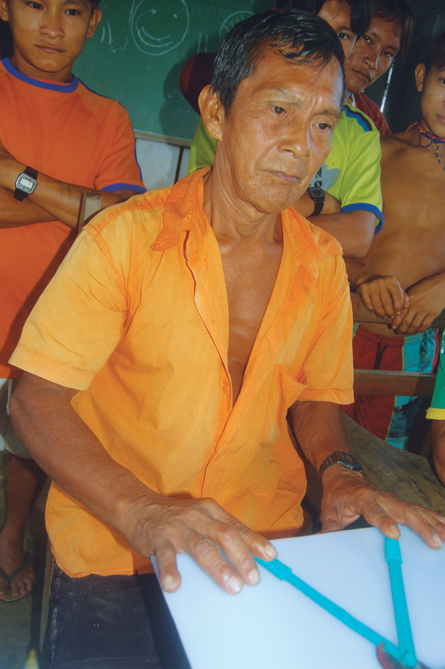Geometric minds skip school
Amazonian villagers grasp abstract spatial concepts
In a South American jungle, far from traffic circles, city squares and the Pentagon, beats the heart of geometry.

Villagers belonging to an Amazonian group called the Mundurucú intuitively grasp abstract geometric principles despite having no formal math education, say psychologist Véronique Izard of Université Paris Descartes and her colleagues.
Mundurucú adults and 7- to 13-year-olds demonstrate as firm an understanding of the properties of points, lines and surfaces as adults and school-age children in the United States and France, Izard’s team reports online May 23 in Proceedings of the National Academy of Sciences.
U.S. children between ages 5 and 7 partially understand geometric space, but not to the same extent as older children and adults, the researchers find.
These results suggest two possible routes to geometric knowledge. “Either geometry is innate but doesn’t emerge until around age 7 or geometry is learned but must be acquired on the basis of general experiences with space, such as the ways our bodies move,” Izard says.
Both possibilities present puzzles, she adds. If geometry relies on an innate brain mechanism, it’s unclear how such a neural system generates abstract notions about phenomena such as infinite surfaces and why this system doesn’t fully kick in until age 7. If geometry depends on years of spatial learning, it’s not known how people transform real-world experience into abstract geometric concepts — such as lines that extend forever or perfect right angles — that a forest dweller never encounters in the natural world.
Whatever the case, the Mundurucú’s keen grip on abstract geometry contrasts with past evidence from Izard’s group that these Amazonian villagers cannot add or otherwise manipulate numbers larger than five. Geometry may have a firmer evolutionary basis in the brain than arithmetic, comments cognitive neuropsychologist Brian Butterworth of University College London.
“If so, this would support recent findings that people who fail to learn arithmetic, or dyscalculics, can still be good at geometry,” Butterworth says.
Philosopher Immanuel Kant proposed in 1781 that people possess innate geometric intuitions about space. Izard’s group sympathizes with that view. Study coauthor and Harvard University psychologist Elizabeth Spelke argues that evolution has endowed people with “core knowledge” about several domains, including physical space.
Other psychologists, such as Nora Newcombe of Temple University in Philadelphia, regard early experiences in moving one’s body through space, acting on objects and observing consequences of actions as fundamental to spatial and geometric knowledge. Izard’s team emphasizes innate geometry over spatial learning in the new paper, Newcombe says.
Izard acknowledges her group’s initial excitement that Mundurucú insights into geometry supported Spelke’s ideas about core knowledge. In 2006 and 2007, Izard and study coauthor Pierre Pica of Université Paris 8 tested 22 adults and eight children in three Mundurucú villages located more than 100 kilometers upriver from any other settlements.
Izard and Pica first probed knowledge of straight lines. Participants viewed images of two-dimensional planes and three-dimensional spheres on a computer screen, which the researchers described as imaginary worlds. Dots located on the surfaces of planes and spheres corresponded to villages that were connected by straight paths.
Volunteers responded to 21 questions, such as “Can more than two lines be drawn through a point?” and “Can a line be made to never cross another line?” Illustrations of a plane or sphere appeared with each question to depict the problem visually.
Mundurucú answered many more questions correctly than would be expected by chance. Accuracy reached more than 90 percent in response to geometric questions about a flat world and more than 70 percent for questions about a spherical world. In both imaginary realms, about 90 percent of villagers agreed on the existence of parallel lines — infinite lines that never cross.
Next, Izard and Pica tested knowledge about triangles. Volunteers again saw a plane and a sphere. In each make-believe world, a pair of dots represented two villages. Two arrows coming out of each dot formed angles, with bottom arrows designating a straight path between the villages and top arrows pointing toward a third, unseen village that completed a triangular shape.
Participants estimated the location of the third village by pointing on the screen. Mundurucú then gauged the angle of paths connecting the unseen village to the visible villages. In some cases, Mundurucú reproduced angles with their hands in a V shape, which an experimenter measured with a special device. On other trials, villagers used the measuring device themselves to form missing angles.
Average Mundurucú estimates for absent angles on flat surfaces, added to measures of the two visible angles, came within 5 degrees of 180, the constant sum of angles in triangles. Average angle estimates for spherical surfaces, added to existing angles, exceeded the constant sum by 9 degrees to 22 degrees.
On the same line and triangle tests, 35 U.S. adults and eight French school children performed comparably to the Mundurucú.
Izard’s team suspected that U.S. 5- to 7-year-olds would show similar geometric insights, providing unambiguous support for core knowledge of concepts about space. To the scientists’ surprise, 52 kids in this age range performed better than chance on line and triangle tests but fell well short of marks set by older children and adults.
In particular, younger children had difficulty taking into account spherical space when thinking about relations between lines and the size of missing angles in triangles.
Izard and her colleagues are now probing the development of geometric knowledge in U.S. and French youngsters during the first few years of life.







